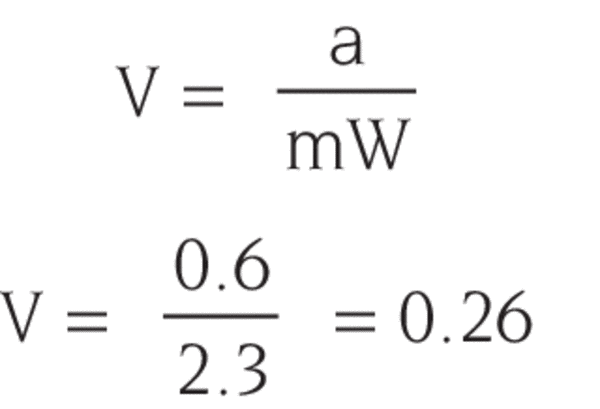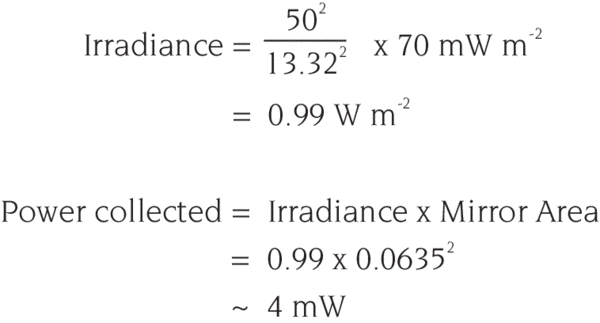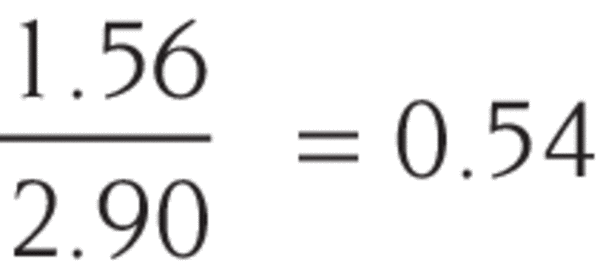The calculation of monochromator throughput may be summarized as follows
P0 = PiVFEmR4
Where:
P0 = Output power in mW
Pi = Power incident on the slit plane in mW
V = Vignetting factor due to the slit aperture being smaller than the source image
F = (F/#illumination)2/(F/#monochromator)2
(It reflects any mismatch in illumination F/# and monochromator F/#; F=1 for F/# Illumination≥F/# monochromator.)
Em = Grating efficiency
R = Reflection efficiency of one of the monochromator mirrors. The R4 factor implies 4 reflections.
Note that usually only Pi and Em have a significant variation with wavelength.
We have omitted some considerations to avoid further confusion. In some circumstances, these secondary considerations can be important. These include:
These are used to increase the throughput into a monochromator and decrease stray light, but careful consideration must be made into how they are used. The Oriel 77259 F/Number Matcher, particularly for use with fibers, has a throughput of about 75%, and increases the F/Number of the illuminating beam by a factor of two over that directly from the fiber. The F/Number Matcher also increases each apparent linear dimension of the illuminating source by a factor of two. Since this may increase vignetting by the monochromator slit, the final throughput may or may not be increased.
The analysis is greatly simplified by assuming uniform rectangular Lambertian sources. Real sources do not conform to this ideal. The high intensity regions of arc sources can sometimes be exploited to your advantage.
Fresnel reflections from the lens surfaces cost power. Use anti-reflection coated lenses in critical situations.
Lens aberrations preclude exact imaging. This is a significant problem with small sources and low F/# lenses that produce a blur circle larger than the expected source image.
The grating in the monochromator is tilted for proper dispersion. This means that the acceptance pyramid is actually a wavelength dependent rectangle, and the entrance slit image at the output is narrower or wider than the entrance slit, depending on grating tilt direction. This can be important for high angles of grating tilt, and in these cases different slit factor widths are needed for best performance. Our variable slits allow you to optimize slit widths easily.
A simple optical sketch shows that rays entering a slit within the acceptance cone of the monochromator but at the top and bottom of the slit, can miss the collection optics. A field lens at the entrance slit can reduce this loss (and a field lens at the exit slit can improve optical detection.) We find no advantage to this solution for most of the monochromatic sources based on small intense arcs or filaments.
Diffraction gratings exhibit complex polarization effects. The grating is more efficient for either s or p polarization. This has no affect on power throughput for an unpolarized input but the monochromatic beam which emerges will be partially polarized and the degree of polarization is wavelength dependent. These phenomena can also cause misleading artifacts in radiometry and spectral analysis.
Estimate the power out of the 77700 MS257™ as a monochromator at 450 nm using the 150 watt xenon arc lamp, 0.6 mm slits, 66919 Source and the 77742 Grating. The 66919 Source has an F/0.85 condenser. The beam from the condenser is focused on the input with a 127 mm focal length lens filling the monochromator input.
The first step is to estimate how much power reaches the slit plane. The source and lamp housing pages lists Lens Multiplication Factors which allow you to estimate the power from the source at any wavelength:
At 450 nm the irradiance from the 150 watt xenon lamp is 14.5 mW m-2 nm-1 at 50 cm and the Lens Conversion Factor is 0.13.
Therefore, the beam from the first lens has ~1.9 mW nm-1 at 450 nm.
Since the source has a rear reflector which contributes about 60% more radiation, we estimate the beam power as 3 mW nm-1. Note too, the secondary focusing lens transmission is about 0.9.
The arc size is 0.5 mm by 2.2 mm. It is important to note that this arc dimension produces only 60% of the total radiation. The outer regions of the arc produce the other 40%. All regions contribute to the 3 mW figure. Because of this, we base the calculation on a source of 0.5 mm by 2.2, providing 1.8 mW nm-1.
Following the pattern from the example on the previous page, the optics produce a 3.9/0.85 = 4.6 magnified image of the source on the slit. The source image size is then 2.3 x 10.1 mm, so with the assumption of a uniform image irradiance, the fraction of image power which passes through the slit is found using the vignetting factor (V). Again, since the image of the source is wider, but not taller, than the slit:
 Over 8,000 products in-stock! & FREE 2-Day shipping on all web orders!* Learn More FREE T-Shirt with orders $250+ Details
Over 8,000 products in-stock! & FREE 2-Day shipping on all web orders!* Learn More FREE T-Shirt with orders $250+ Details


 Ultra-High Velocity
Ultra-High Velocity